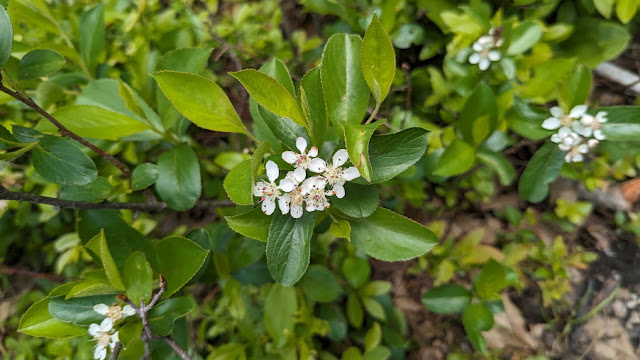 |
| A large, well armored Snapping Turtle. |
It's a safe bet that a snapper up on dry land is a female, as males have little reason to leave the safety of the lake. Did you notice those long, sharp claws for digging a nest in hard packed ground?
 |
| Out of water and exposed to any predator brave enough to tangle with that strong jaw. |
I've written previously about snappers and their deceptive technique to increase the odds for their offspring to survive. A single female Snapping Turtle will dig multiple nest holes, but will only place her eggs in one of them. A predator won't know where the eggs are, and after a failed attempt or two at finding food, may give up. On aptly named Turtle Island in Lake Wicwas I've seen dozens of holes and sand piles where snappers have created false nests to stymie predators.
Another unusual trait of Snapping Turtles is that the sex of the hatchling isn't determined when the egg is fertilized, but rather the resulting gender is determined by the temperature of the ground in which it develops. If the temperature of the nest is below 68 degrees Fahrenheit, all the eggs will be female. If the temperature is above 73 degrees they will all be male. Between these temperatures there will be some of each gender. Personally, I'm hoping for lots of little boy turtles this summer!
She's not the only reptile out nest building. This Painted Turtle was doing her thing in the same general area a few days earlier.
 |
| A Painted Turtle lays her eggs. |
Both of these turtles managed to make their way about a hundred yards through thick growth to find their nesting spot.
On the much smaller end of the herpetofauna scale (the collective term for amphibians and reptiles) is this little Red Eft that happened to be walking down the same dirt road.
 |
| That's the tip of my shoe. |
These mid-life-stage Eastern Newts aren't rare, but it's always a treat to find one creeping along a hiking trail in the woods, most often after a summer rain.
Talking about trails, the Chokeberry are blooming now. I found these right beside the trail at the very summit of Red Hill.
 |
| Black Chokeberry on Red Hill in Moultonborough. |
Chokeberry is well adapted to growing in wet areas and many are growing along the shores of local lakes and wetlands.
 |
| And on the shores around Lake Wicwas. |
In the fall they'll have large black berries that are consumed by birds as well as mammals large and small.
Did you find some Lady's Slippers to enjoy this week? This Tiger Swallowtail butterfly did.
 |
| A Tiger Swallowtail looks for nectar in a Pink Lady's Slipper. |
However, the butterfly left unsatisfied as Lady's Slippers don't produce nectar! These are two of several Lady's Slippers growing right beside the trail leading up to Crockett's Ledge in the Hamlin Town Forest.
Keep your eye out now for pretty white Bunchberry flowers down low to the ground.
 |
| Bunchberry will have red fruit in the fall. |
These are woodland plants, found mostly in slightly open areas of damp forests.
Following up on the bird nests of last week, I forgot to mention one, a phoebe nest that's built on a beam under our deck. The poor bird flies off the nest every time we go by the deck. That's one bird that's getting its exercise. And there's yet another nest under construction, one who's location is unknown to me.
 |
| An American Robin gathers nest building material. |
It's late for a Robin's first nest, and since Robins will often have two or even three broods each summer and don't usually reuse a nest, this bird is probably working on nest number two.
Have you noticed the dragonflies have emerged? I've seen several of various shapes and colors including swarms of Chalk-fronted Corporals which are common at this point in the season.
 |
| Chalk-fronted Corporal. |
But the most beautiful dragonfly I saw this week was this one with fabulous clear wings that reflect the light with the most delectable colors.
I haven't been able to identify it, but I were to name it I'd call it the Rainbow Dragon.There were signs this week the second pair of loons are preparing their nest - maybe there will be news to report next week.


Beautiful Photos!
ReplyDelete